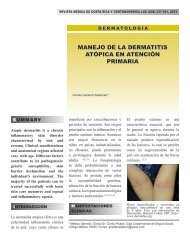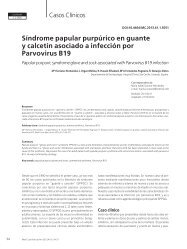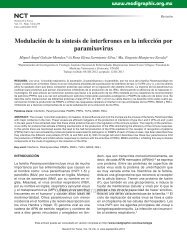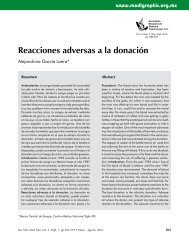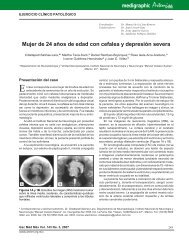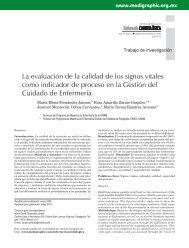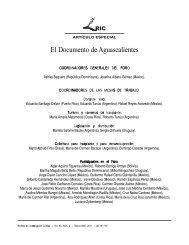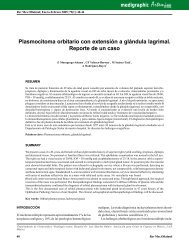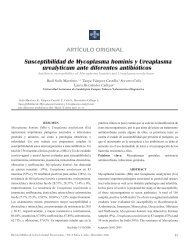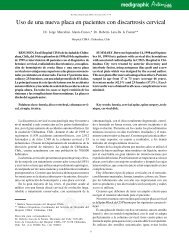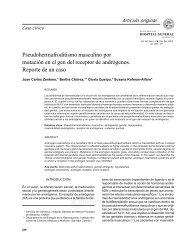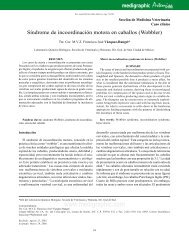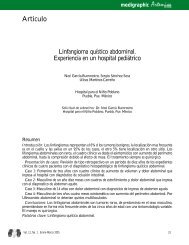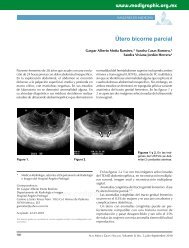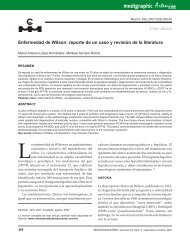Fanconi – Bickel Syndrome – two cases report - edigraphic.com
Fanconi – Bickel Syndrome – two cases report - edigraphic.com
Fanconi – Bickel Syndrome – two cases report - edigraphic.com
You also want an ePaper? Increase the reach of your titles
YUMPU automatically turns print PDFs into web optimized ePapers that Google loves.
166<br />
Case 2<br />
Eight month old female infant, who is born of second<br />
conception (sibling of case 1), delivered via naturalis<br />
with birth weight of 2,500 g, length of 48 cm and head<br />
circumference of 32 cm. During the neonatal period, was<br />
hospitalized for transient tachypnea, transient unconjugated<br />
hyperbilirubinemia and hypoglycemia not associated<br />
with seizures. The newborn metabolic screening was<br />
negative, however the estimation of blood galactose level<br />
later <strong>report</strong>ed to be elevated.<br />
At the age of 7 month, infant was brought to hospital<br />
for delay attaining age appropriate milestones (not attained<br />
head control, not started sitting and crawling).<br />
The physical examination revealed weight of 7,950<br />
g, length of 63 cm, which are less for age (3 rd centile),<br />
Doll-like face, prominent abdomen and hepatomegaly<br />
Figure 4. Case 2 exhibits Doll-like face and hepatomegaly (marked<br />
by lines).<br />
Case 1<br />
Annals of Hepatology 7(2) 2008: 163-167<br />
www.m<strong>edigraphic</strong>.<strong>com</strong><br />
of about 6 cm below the right costal margin (Figure 4).<br />
Because of these finding, FBS was suspected and the<br />
following laboratory analysis were requested: Arterial<br />
blood gas, Serum and Urinary Electrolytes, calcium,<br />
phosphorous, cholesterol, triglyceride, ultra sonogram<br />
of abdomen and x-ray of thorax and long bone. They<br />
were <strong>report</strong>ed as metabolic acidosis (Table I), rickets<br />
and hepatomegaly devoid of any specific ultrasonographic<br />
pattern. Based on these results, liver biopsy was<br />
done and revealed histopathological changes typical of<br />
glycogenosis (Figure 1). Hence, the suspicion of FBS<br />
was confirmed and treatment was continued with phosphate<br />
and bicarbonate replacement. The dietary advice<br />
was given based on the calculation of 140 kcal/kg of<br />
body weight, protein of 4.5 gm/kg of body weight in<br />
the form of maternized cow’s milk, formula of soya, puree<br />
of fruits and vegetables.<br />
Discussion<br />
FBS is a rare clinical entity and rare presentation with<br />
in the same family affecting the infants between the ages<br />
of 2 month to 1 year of life. The clinical picture, which is<br />
noticed in majority of the patients, is characteristic faces<br />
«Moon- shaped» face or «Doll- like» face. In addition,<br />
short stature, rickets, protuberant abdomen, and<br />
hepatomegaly 3-5 are associated features in FBS. In addition,<br />
biochemical changes encountered as a consequence<br />
of the altered Proximal Renal Tubular function (glucosuria,<br />
phosphaturia, bicarbonate loss and hypophosphatemia,<br />
aminoaciduria). Preprandial ketotic hypoglycemia<br />
and significant post prandial hyperglycemia and<br />
hypergalactesemia are noted due to low hepatic uptake.<br />
There is also hypoinsulinemia due to altered sensitivity<br />
of β cells of Pancreas to glucose, associated with reduced<br />
release of monosachroide by hepatic cells during fasting<br />
Case 2<br />
Figure 5. Percutaneous liver biopsy of Case 1 and Case 2 (HE 40x) showed large and ballooned hepatocytes with clear cytoplasm.



